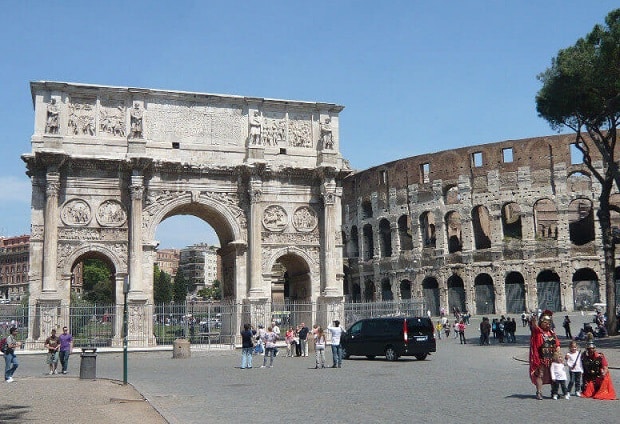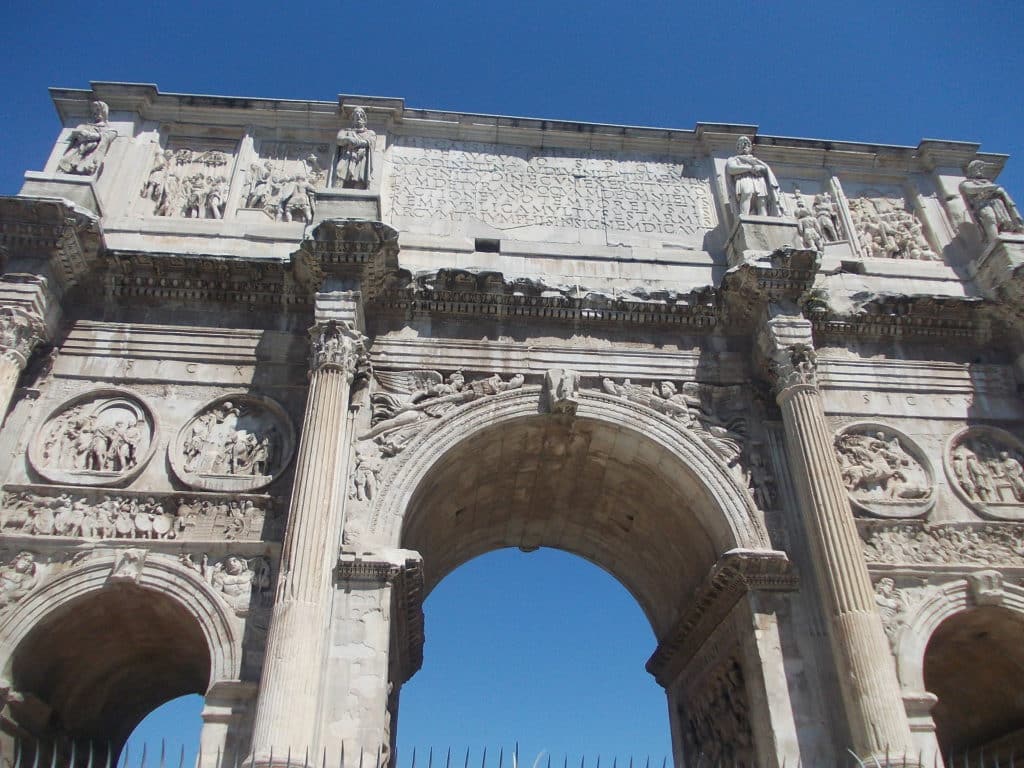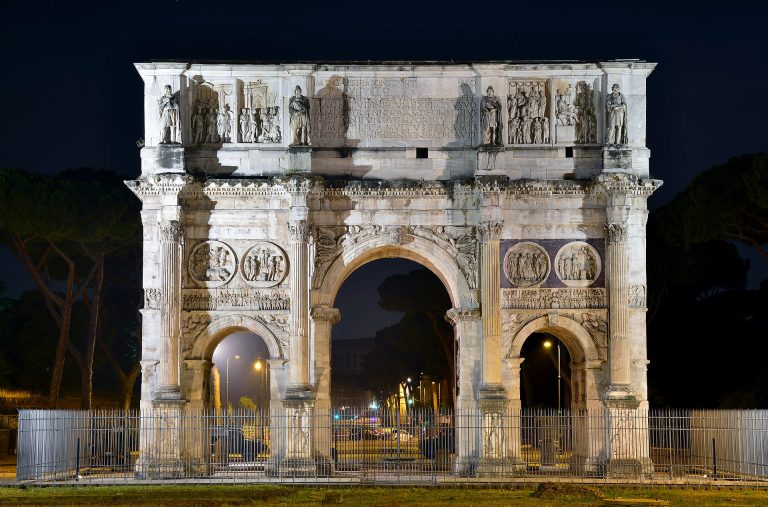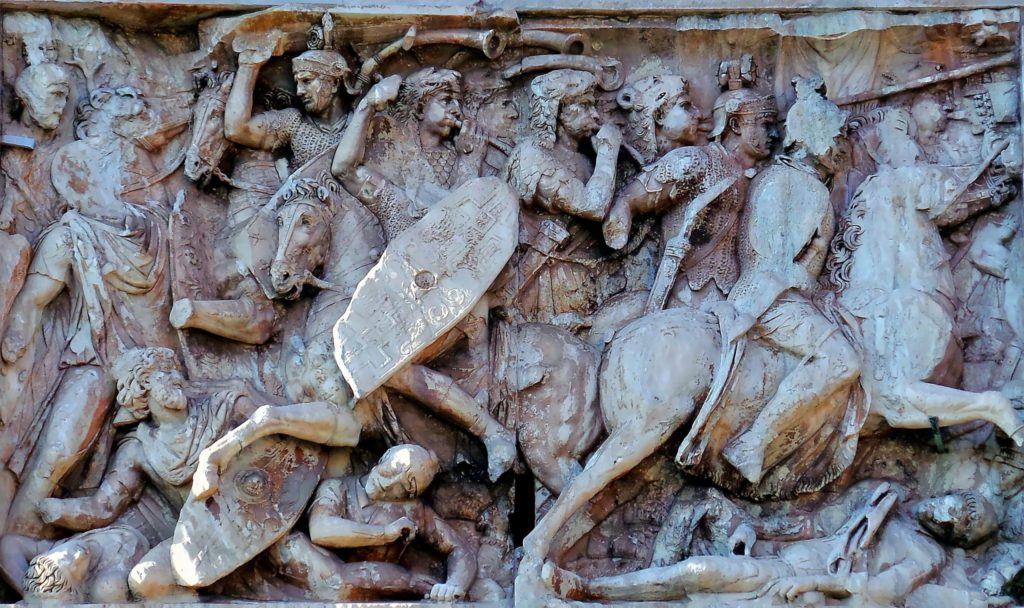The Arch of Constantine is the largest surviving Roman triumphal Arch
The Arch of Constantine is one of the three ancient triumphal arches left in Rome. The other two are the arch of Tito (approximately 81–90) and the Arco di Settimio Severo (202–203). It was the last great monument of imperial Rome. It was erected to commemorate the victory of Costantino I on Maxentius.

Located along the route traveled by the triumphs, in the stretch between the Circus Maximus and the Arch of Tito, it is the largest honorary arc that came up to us. He was erected on the ancient “via Triumphalis”, (the path reserved for the processions of the triumphant ones who march towards the Capitol), to celebrate the battle at Ponte Milvio of 312 AD, when the emperor defeated the rival Maxentius.
As reported by the site of the Colosseum park, the decoration in relief marble slabs was conceived and created in the Constantinian age according to a unitary project, using mostly bare materials from other imperial monuments. On the main faces of the arch and on the sides, according to symmetrical schemes, reliefs of the age of Trajan, Hadrian, Marcus Aurelio and finally, in the lower sector, of the age of Constantine, alternate.
All the faces of the emperors that appear in the reliefs have been remodeled in the likeness of Constantine, with the Nimbo to notice the imperial majesty.

The many images that populate the arch are united by a precise guiding thread: the celebration of the political design of restoration of the empire wanted by Constantine. He wants to be celebrated and recognized as a new referee of the fate of Rome and legitimate triumphant in the rival Massenzio and to do this he chooses a traditional and well -rooted monument in imperial history: the triumphal arch.
The building is designed to narrate its victories, but is decorated with older images from other buildings, so that the images of the past, with the narration of the wars and triumphs of the great protagonists of the Empire, can legitimize the power of the same Constantine. A guarantee of the solidity of his government and the political consensus of him.

As reported by the inscription on the central fornice, the Arch was dedicated by the Senate to commemorate the victory of Constantine I against Maxentius in the battle of Ponte Milvio (28th of October 312 AD) and was inaugurated in 315 AD on the occasion of the ten years of the emperor’s reign.
The general dimensions of the prospectus are 21 meters high, 25.9 meters wide and 7.4 m depth.

The arch is built in a square marble work in the pylons, while the penthouse, which houses an accessible space, is made of masonry and cement covered outside the marble blocks. Different qualities have been used indifferently, reused by oldest monuments, and most of the architectural elements and sculptures of its decoration have also been reused.
The architectural structure resumes very closely that of the Arco di Settimio Severo in the Roman Forum, with the three ovens framed by columns protruding on high plinths; Some decorative themes, such as the victories of the central fornice plumes, are also taken from the same model.
As Archaeo Roma reports, Constantine designed the arch to celebrate his triumphs, but decides to decorate it with charmed elements from other monuments that were already popular and familiar to the Roman people. The historical glorifications of the great characters of the Empire were the expression of the authority to which Constantine had to resort to validate his power and the endorsement of political favor.
DISCOVER THE HISTORY OF THE CIRCUS MAXIMUS
The arch is three fornici, the central one is the largest, 6.50 meters wide for 11.45 in height and in the whole it is 21 meters high and 25.70 wide. The arch is a merger of sculptures and architectural parts resulting from dissimilar commemorative cultures and architectures, such as those of the era of Trajan, Adriano and Commodus. This explains why the city, which had long been abandoned the peculiarities of capital in that period (will be replaced in favor of Constantinople), had no more sculptors to boast with art such glorious monument, thus symbolizing the decline of the Roman Empire of West.
At the center of the attic, located on a long passing, the historic inscription is located:
“Imp (Erators) Caes (ARI) F (Lavio) Constantino Maximo P (io) F (Helici) Augustus S (ENATUS) P (opulus) Q (EU) R (Omanus) Quod InstinTUTU divinitatis Mentis Magnitude cum exettu his tam de Ty they will quam de omni eius faction a tempore iustis Rem Publicam Ultus est Armis Arcum Triumphis Insignem dicavit “
That is: “To the emperor Cesare Flavio Costantino Massimo, Pio, Felice, Augusto, the Senate and the Roman people, since by the inspiration of the divinity and for the greatness of his spirit with his army he revealed at the same time the state on a tyrant and On all its faction with right weapons, they dedicated this arched arc to triumphs “.
In the phrase “Instinto Divinitatis” (“By inspiration of the divinity”) an unlikely proof of the conversion of Constantine to Christianity during the battle was interpreted.
This following a vision of the cross associated with the writing “In hoc Signo Vinces” (in this sign you will win) which will lead to the edict of Milan in the year 313. In this year Constantine and Licinio decreed freedom of worship throughout the Empire, also promoting the spread of Christianity.
With the Edict of the Tessalonica of 380 AD Emperor Theodosius I, said by Christians “the great”, issued the measure that Christianity became the unique and mandatory religion of the Roman Empire.
The important panels between the statues are dedicated to Marcus Aurelio, while the rounds (and perhaps also the arch himself) are by the emperor Hadrian. The decorations on the central and lower part have been specially sculpted, while the frieze shows Constantine’s army to reject Maxentius’s troops in the Tiber.
